SH1 WAIKATO EXPRESSWAY
NGĀRUAWĀHIA SECTION
110 km/h ROAD SAFETY RETROFIT
1982
Detail Design Road Safety Audit
Act
2 March 2022
Information
Prepared for:
Waka Kotahi NZ Transport Agency
Official
Prepared by:
s 9(2)(a)
the Project Number:
310205002.100.0104
under
Released
1982
Act
Information
Official
the
under
Released
 SH1 Waikato Expressway Ngāruawāhia Section
110 km/h Road Safety Retrofit
Revision Description
Author
Date
Quality
Date
Independent
Date
Check
Review
SH1 Waikato Expressway Ngāruawāhia Section
110 km/h Road Safety Retrofit
Revision Description
Author
Date
Quality
Date
Independent
Date
Check
Review
1982
Act
Information
Official
the
under
Released
Project Number: 310205002.100.0104
 SH1 Waikato Expressway Ngāruawāhia Section
110 km/h Road Safety Retrofit
SH1 Waikato Expressway Ngāruawāhia Section
110 km/h Road Safety Retrofit
This document entitled SH1 Waikato Expressway Ngāruawāhia Section was prepared by Stantec New
Zealand (Stantec) for the account of Waka Kotahi NZ Transport Agency (the Client). Any reliance on this
document by any third party is strictly prohibited. The material in it reflects Stantec’s professional
1982
judgment in light of the scope, schedule and other limitations stated in the document and in the contract
between Stantec and the Client. The opinions in the document are based on conditions and information
existing at the time the document was published and do not take into account any subsequent changes.
In preparing the document, Stantec did not verify information supplied to it by others. Any use which a
Act
third party makes of this document is the responsibility of such third party. Such third party agrees that
Stantec shal not be responsible for costs or damages of any kind, if any, suffered by it or any other third
party as a result of decisions made or actions taken based on this document.
s 9(2)(a)
Prepared by:
Information
Official
Reviewed by:
the
under
Approved by:
Released
Project Number: 310205002.100.0104
link to page 6 link to page 7 link to page 7 link to page 8 link to page 8 link to page 8 link to page 9 link to page 9 link to page 9 link to page 11 link to page 13 link to page 14 link to page 14 link to page 14 link to page 14 link to page 16 link to page 16 link to page 18 link to page 19 link to page 19 link to page 20 link to page 20 link to page 21 link to page 23 link to page 24 link to page 24 link to page 24 link to page 24 link to page 25 link to page 25 link to page 26 link to page 9 link to page 10 link to page 10 link to page 15 link to page 15 link to page 17 link to page 19 link to page 19 link to page 21
 SH1 Waikato Expressway Ngāruawāhia Section
110 km/h Road Safety Retrofit
Table of Contents
SH1 Waikato Expressway Ngāruawāhia Section
110 km/h Road Safety Retrofit
Table of Contents
1982
ACRONYMS / ABBREVIATIONS ............................................................................................... II
1
INTRODUCTION ........................................................................................................... 1
1.1
Safety Audit Definition and Purpose .............................................................................................. 1
Act
1.2
The Project .................................................................................................................................... 2
1.3
The Road Safety Audit Team ........................................................................................................ 2
1.4
Previous Road Safety Audits ......................................................................................................... 2
1.5
Scope of this Road Safety Audit .................................................................................................... 3
1.6
Briefing, Audit, and Exit Meetings ................................................................................................. 3
1.7
Report Format ............................................................................................................................... 3
1.8
Documents Provided ..................................................................................................................... 5
1.9
Disclaimer ...................................................................................................................................... 7
2
SAFETY CONCERNS................................................................................................... 8
2.1
Safety Barriers ............................................................................................................................... 8
2.1.1
Height and condition of existing barriers Comment ...................................................................... 8
2.1.2
Position of lighting columns Comment .......................................................................................... 8
Information
2.2
Cross-section ............................................................................................................................... 10
2.2.1
Median shoulder width Moderate ................................................................................................ 10
2.2.2
Aquaplaning potential Moderate .................................................................................................. 12
2.3
Cyclists ........................................................................................................................................ 13
2.3.1
Cyclist road signs and markings Comment ................................................................................. 13
2.4
Road Signs and Markings ........................................................................................................... 14
2.4.1
RRPMs and ATP Comment ........................................................................................................ 14
2.4.2
Wide shoulder markings Comment ............................................................................................. 15
Official
3
AUDIT STATEMENT .................................................................................................. 17
4
RESPONSE AND DECISION STATEMENTS ............................................................ 18
the
4.1
Designer’s Responses................................................................................................................. 18
4.2
Safety Engineer’s Comment (if applicable) ................................................................................. 18
4.3
Project Manager’s Decisions ....................................................................................................... 18
4.4
Designer’s Statement .................................................................................................................. 19
4.5
Road Safety Audit Close Out ...................................................................................................... 19
5
REFERENCES ........................................................................................................... 20
under
LIST OF TABLES
Table 1: Crash Frequency Description ......................................................................................................... 3
Table 2: Concern Assessment Rating Matrix ................................................................................................ 4
Table 3: Concern Categories ........................................................................................................................ 4
LIST OF FIGURES
Figure 1: Offsets to frangible and non-frangible lighting columns
9
Figure 2: Shear base orientation to traffic
9
Figure 3: Proposed surfaced median width
11
Figure 4: Existing buffer strip Rangiriri to Ohinewai (Google, 2021)
13
Released
Figure 5: Exit ramp cyclist crossing at Cambridge (west) interchange (Google, 2019)
13
Figure 6: RRPMs on Longswamp to Rangiriri section (Google, 2021)
15
Project Number: 310205002.100.0104
i
 SH1 Waikato Expressway Ngāruawāhia Section
110 km/h Road Safety Retrofit
Acronyms / Abbreviations
SH1 Waikato Expressway Ngāruawāhia Section
110 km/h Road Safety Retrofit
Acronyms / Abbreviations
1982
ATP
audio tactile profiled (road markings)
RRPM
reflectorised raised pavement marker
Waka Kotahi
Waka Kotahi NZ Transport Agency
Act
Information
Official
the
under
Released
Project Number: 310205002.100.0104
ii
 SH1 Waikato Expressway Ngāruawāhia Section
110 km/h Road Safety Retrofit
1 Introduction
1
Introduction
1.1 Safety Audit Definition and Purpose
SH1 Waikato Expressway Ngāruawāhia Section
110 km/h Road Safety Retrofit
1 Introduction
1
Introduction
1.1 Safety Audit Definition and Purpose
1982
A road safety audit is a term used international y to describe an independent review of a future road
project to identify any safety concerns that may affect the safety performance. The audit team considers
Act
the safety of all road users and qualitatively reports on road safety issues or opportunities for safety
improvement.
A road safety audit is therefore a formal examination of a road project, or any type of project which affects
road users (including cyclists, pedestrians, mobility impaired etc.), carried out by an independent
competent team who identify and document road safety concerns.
A road safety audit is intended to help deliver a safe road system and is not a review of compliance with
standards.
The primary objective of a road safety audit is to deliver a project that achieves an outcome consistent
Information
with Road to Zero and the Safe System approach, which is a safe road system free of death and serious
injury. The road safety audit is a safety review used to identify all areas of a project that are inconsistent
with a Safe System and bring those concerns to the attention of the client so that the client can make a
value judgement as to appropriate action(s) based on the risk guidance provided by the safety audit team.
The key objective of a road safety audit is summarised as:
Official
'to deliver completed projects that contribute towards a safe road system that is free of death and serious
injury by identifying and ranking potential safety concerns for all road users and others affected by a road
project.'
the
A road safety audit should desirably be undertaken at project milestones such as:
• concept stage (part of business case);
• scheme or preliminary design stage (part of pre-implementation);
under
• detail design stage (pre-implementation or implementation); or
• pre-opening or post-construction stage (implementation or post-implementation).
A road safety audit is not intended to be a technical or financial audit and does not substitute for a design
check of standards or guidelines. Any recommended treatment of an identified safety concern is intended
to be indicative only, and to focus the designer on the type of improvements that might be appropriate. It
is not intended to be prescriptive and other ways of improving the road safety or operational problems
identified should also be considered.
Released
Project Number: 310205002.100.0104
1
 SH1 Waikato Expressway Ngāruawāhia Section
110 km/h Road Safety Retrofit
1 Introduction
SH1 Waikato Expressway Ngāruawāhia Section
110 km/h Road Safety Retrofit
1 Introduction
In accordance with the procedures set down in the NZTA Road Safety Audit Procedures for Projects
Guidelines - Interim release May 2013 the audit report should be submitted to the client who wil instruct
the designer to respond. The designer should consider the report and comment to the client on each of
any concerns identified, including their cost implications where appropriate, and make a recommendation 1982
to either accept or reject the audit report recommendation.
For each audit team recommendation that is accepted, the client wil make the final decision and brief the
designer to make the necessary changes and/or additions. As a result of this instruction the designer
Act
shall action the approved amendments. The client may involve a safety engineer to provide commentary
to aid with the decision.
Decision tracking is an important part of the road safety audit process. A decision tracking table is
embedded into the report format at the end of each set of recommendations. It is to be completed by the
designer, safety engineer, and client for each issue, and should record the designer's response, client's
decision (and asset manager's comments in the case where the client and asset manager are not one
and the same) and action taken. Decision tracking of safety concerns ranked as a comment is optional.
A copy of the report including the designer's response to the client and the client's decision on each
Information
recommendation shal be given to the road safety audit team leader as part of the important feedback
loop. The road safety audit team leader wil disseminate this to team members.
1.2 The Project
The existing roadside and median safety barriers along SH1 Waikato Expressway (Ngāruawāhia Section
from Gordonton Road interchange to Te Rapa Bypass interchange) wil be upgraded to meet the
Official
standards set by Waka Kotahi for a 110 km/h speed limit. This wil include replacing existing median and
roadside barriers with MASH standard barriers, adding roadside barriers where none are currently
provided, widening the shoulders to 3.0 m, and sealing the grassed median.
the
1.3 The Road Safety Audit Team
This road safety audit has been carried out in accordance with the NZTA Road Safety Audit Procedure for
Projects Guidelines - Interim release May 2013, by:
under
• Keith Weale, Stantec,
• Kirsty Horridge, Stantec. and
• Heather Liew, Waka Kotahi.
1.4 Previous Road Safety Audits
There have been no previous road safety audits of this project.
Released
Project Number: 310205002.100.0104
2
link to page 8 link to page 9
 SH1 Waikato Expressway Ngāruawāhia Section
110 km/h Road Safety Retrofit
1 Introduction
1.5 Scope of this Road Safety Audit
SH1 Waikato Expressway Ngāruawāhia Section
110 km/h Road Safety Retrofit
1 Introduction
1.5 Scope of this Road Safety Audit
This is a preliminary design road safety audit of the project described in Section
1.2.
1982
1.6 Briefing, Audit, and Exit Meetings
A site visit was not considered necessary or advisable due to the widespread Covid-19 omicron virus.
Act
The safety audit team therefore conducted the safety audit using the most recent May 2021 Google
Street View images and December 2021 Argonaut Roadrunner videos instead.
An exit meeting was held with Shane Small and Thayalan Sivachelvan of Waka Kotahi and Luke Rogers
and Leshego Mpe of Stel ar Projects on 1 March 2022.
1.7 Report Format
The potential road safety problems identified have been ranked as fol ows.
The expected crash frequency is qualitatively assessed on the basis of expected exposure (how many
Information
road users wil be exposed to a safety issue) and the likelihood of a crash resulting from the presence of
the issue. The severity of a crash outcome is qualitatively assessed on the basis of factors such as
expected speeds, type of collision, and type of vehicle involved.
Reference to historic crash rates or other research for similar elements of projects, or projects as a whole,
have been drawn on where appropriate to assist in understanding the likely crash types, frequency and
likely severity that may result from a particular concern.
Official
The frequency and severity ratings are used together to develop a combined qualitative risk ranking for
each safety issue using the concern assessment rating matrix in
Table 1. The qualitative assessment
the
requires professional judgement and a wide range of experience in projects of all sizes and locations.
In ranking specific concerns, the auditors have considered the objectives of the Safe System approach,
i.e. to minimise fatal or serious injury crashes.
In undertaking this assessment, the safety audit team has utilised the following descriptor tables to enable
a fair and reasonable rating of the risks.
under
Table 1: Crash Frequency Description
Crash Frequency
Indicative Description
Frequent
Multiple crashes (more than one per year)
Common
1 every 1 to 5 years
Occasional
1 every 5 to 10 years
Released
Infrequent
Less than 1 every 10 years
Project Number: 310205002.100.0104
3
link to page 10
 SH1 Waikato Expressway Ngāruawāhia Section
110 km/h Road Safety Retrofit
1 Introduction
SH1 Waikato Expressway Ngāruawāhia Section
110 km/h Road Safety Retrofit
1 Introduction
Crash severity is determined on the likelihood of a crash resulting in death or serious injury. The reader is
advised that the severity of an injury is determined in part by the ability of a person to tolerate the crash
forces. An able-bodied adult wil have a greater ability to recover from higher trauma injuries, whereas an
elderly person may have poor ability to recover from high trauma injuries. The auditors consider the likely 1982
user composition, and hence the likely severity of injury to that user.
Table 2: Concern Assessment Rating Matrix
Act
Severity
Frequency (probability of a crash)
(likelihood of death or serious injury)
Frequent
Common
Occasional
Infrequent
Very likely
Serious
Serious
Significant
Moderate
Likely
Serious
Significant
Moderate
Moderate
Unlikely
Significant
Moderate
Minor
Minor
Very unlikely
Moderate
Minor
Minor
Minor
While all safety concerns should be considered for action, the client or nominated project manager wil
Information
make the decision as to what course of action wil be adopted based on the guidance given in this ranking
process with consideration to factors other than safety alone. As a guide a suggested action for each
concern category is given in
Table 3.
Table 3: Concern Categories
Concern
Suggested Action
Official
Serious
Major safety concern that must be addressed and requires changes to avoid serious safety
consequences.
Significant
Significant safety concern that should be addressed and requires changes to avoid serious
the
safety consequences.
Moderate
Moderate safety concern that should be addressed to improve safety.
Minor
Minor safety concern that should be addressed where practical to improve safety.
under
In addition to the ranked safety issues, it may be appropriate for the safety audit team to provide
additional comments with respect to items that may have a safety implication but lie outside the scope of
the safety audit. A comment may include items where the safety implications are not yet clear due to
insufficient detail for the stage of project, items outside the scope of the audit such as existing issues not
impacted by the project or an opportunity for improved safety but not necessarily linked to the project
itself. While typically comments do not require a specific recommendation, the auditors may give
suggestions in some instances.
Decision tracking of safety concerns ranked as a comment is optional.
Released
Project Number: 310205002.100.0104
4

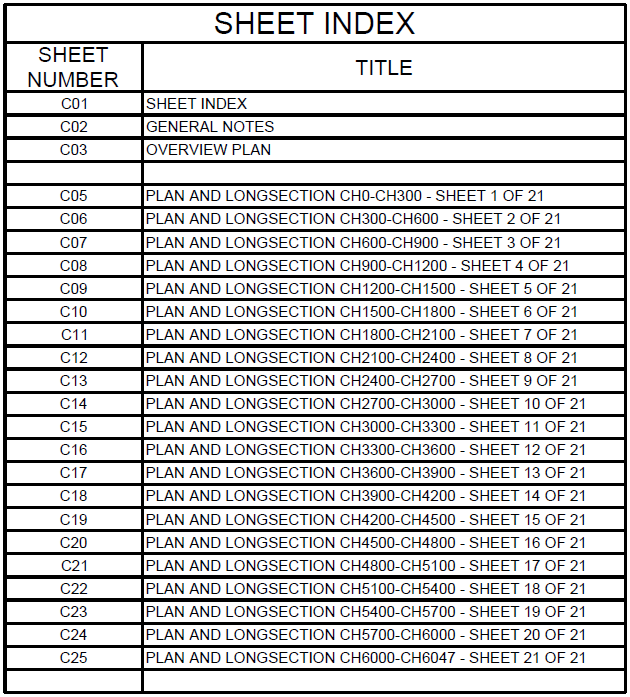
 SH1 Waikato Expressway Ngāruawāhia Section
110 km/h Road Safety Retrofit
1 Introduction
1.8 Documents Provided
SH1 Waikato Expressway Ngāruawāhia Section
110 km/h Road Safety Retrofit
1 Introduction
1.8 Documents Provided
The fol owing drawings were provided for the audit.
1982
Act
Information
Official
the
under
Released
Project Number: 310205002.100.0104
5

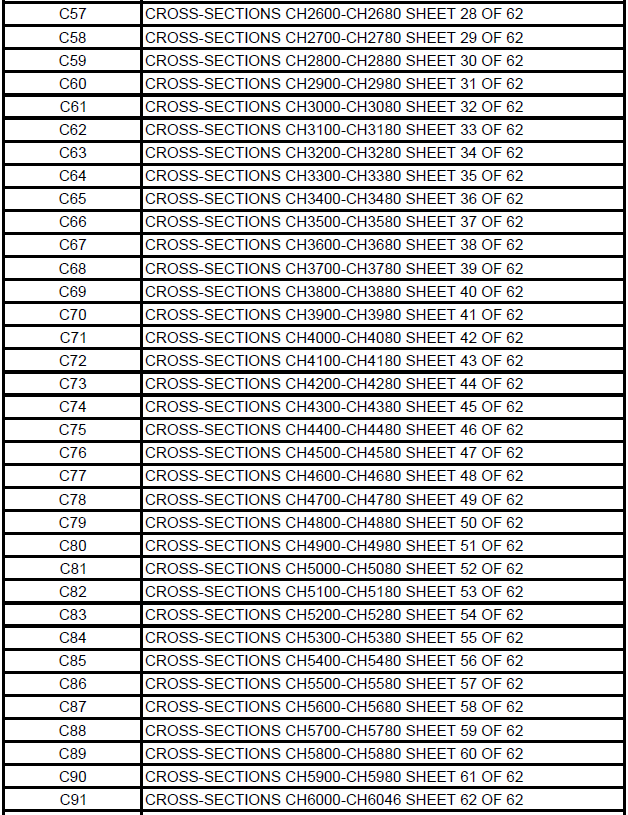
 SH1 Waikato Expressway Ngāruawāhia Section
110 km/h Road Safety Retrofit
1 Introduction
SH1 Waikato Expressway Ngāruawāhia Section
110 km/h Road Safety Retrofit
1 Introduction
1982
Act
Information
Official
the
under
Released
Project Number: 310205002.100.0104
6
 SH1 Waikato Expressway Ngāruawāhia Section
110 km/h Road Safety Retrofit
1 Introduction
1.9 Disclaimer
SH1 Waikato Expressway Ngāruawāhia Section
110 km/h Road Safety Retrofit
1 Introduction
1.9 Disclaimer
The findings and recommendations in this report are based on an examination of available relevant plans,
the specified road and its environs, and the opinions of the road safety audit team. However, it must be
1982
recognised that eliminating safety concerns cannot be guaranteed since no road can be regarded as
absolutely safe and no warranty is implied that all safety issues have been identified in this report. Safety
audits do not constitute a design review nor are they an assessment of standards with respect to Act
engineering or planning documents.
Readers are urged to seek specific technical advice on matters raised and not rely solely on the report.
While every effort has been made to ensure the accuracy of the report, it is made available on the basis
that anyone relying on it does so at their own risk without any liability to the safety audit team or their
organisations.
Information
Official
the
under
Released
Project Number: 310205002.100.0104
7
link to page 15
 SH1 Waikato Expressway Ngāruawāhia Section
110 km/h Road Safety Retrofit
2 Safety Concerns
2
Safety Concerns
2.1 Safety Barriers
SH1 Waikato Expressway Ngāruawāhia Section
110 km/h Road Safety Retrofit
2 Safety Concerns
2
Safety Concerns
2.1 Safety Barriers
1982
2.1.1
HEIGHT AND CONDITION OF EXISTING BARRIERS
COMMENT
Act
The drawings state, ‘Existing barriers are to remain (depending on condition). Contractor to replace /
make adjustments where rail height is non-compliant after pavement treatments.’ Presumably, this should
apply to the existing terminals as well.
This places the onus on the contractor to decide if the existing rigid barriers, semi-rigid barriers, and
terminals need to be replaced or lifted. Unless specified in the project specifications, the contractor would
have no suitability criteria or dimensional tolerances on which to decide what barriers and terminals
should be replaced or lifted. This could result in deficient barriers and terminals remaining, or serviceable
barriers and terminals being replaced unnecessarily.
Recommendation(s)
Information
1 Preferably, add ‘on instruction of the Engineer’ to the notes on the drawing to relieve the
contractor of the responsibility of deciding on safety matters.
2 Alternatively, specify precisely what parameters and tolerances should be applied when deciding
whether an existing barrier system should be adjusted or replaced.
Official
Optional Decision Tracking
Designer
response
the
Client safety
engineer
comment
Client decision
Action taken
under
2.1.2
POSITION OF LIGHTING COLUMNS
COMMENT
The proposed offsets to frangible and non-frangible objects are shown i
n Figure 1. However, the
examples of a frangible and a non-frangible lighting column might be the wrong way around.
Released
Project Number: 310205002.100.0104
8
link to page 15

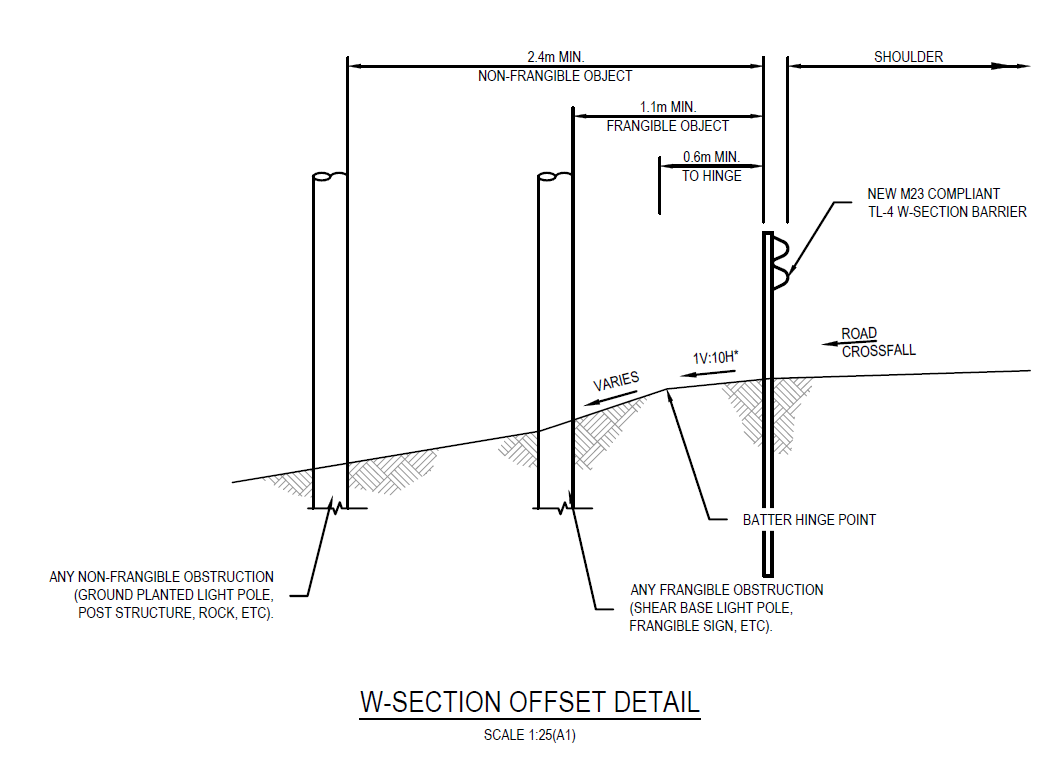
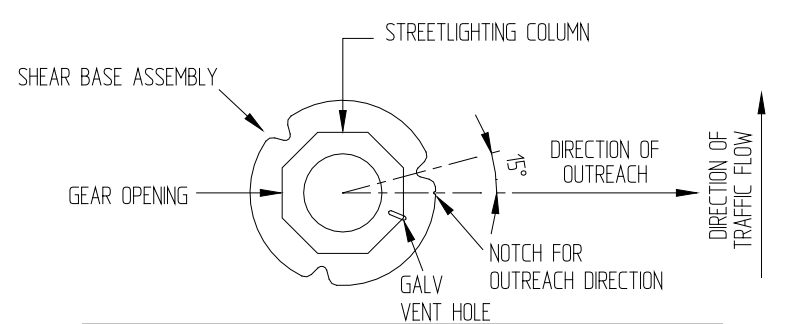 SH1 Waikato Expressway Ngāruawāhia Section
110 km/h Road Safety Retrofit
2 Safety Concerns
SH1 Waikato Expressway Ngāruawāhia Section
110 km/h Road Safety Retrofit
2 Safety Concerns
1982
Act
Information
Figure 1: Offsets to frangible and non-frangible lighting columns
Official
Shear base lighting columns are considered to be frangible, but they are designed to be struck directly
and at high speed by a vehicle. The influence of a barrier in front of a shear base column on its
performance is not currently certain. It is, however, likely that the energy required to shear the lighting
the
column off its base would be reduced by the barrier, and that the angle of impact required for the bolts to
slip off the base plate notches would differ. Note the precise 15° orientation of the notches in the base
plate to the direction of traffic i
n Figure 2.
under
Released
Figure 2: Shear base orientation to traffic
Project Number: 310205002.100.0104
9
link to page 17
 SH1 Waikato Expressway Ngāruawāhia Section
110 km/h Road Safety Retrofit
2 Safety Concerns
SH1 Waikato Expressway Ngāruawāhia Section
110 km/h Road Safety Retrofit
2 Safety Concerns
On the other hand, ground planted lighting columns are general y considered to be frangible, and do not
need to be struck at any particular angle to collapse as designed.
Therefore, it is suggested that ground planted lighting columns could be placed closer to the barrier than 1982
shear base columns.
The road safety audit team has assigned a comment against the risk ranking of this safety concern as all
objects are intended to be at least 1.1 m from the safety barrier.
Act
Recommendation(s)
1 Consider al owing ground planted lighting columns to be positioned much closer to the barriers
than proposed.
2 Where existing shear base lighting columns are to be relocated, specify ground-planted frangible
lighting columns to replace the slip-base columns behind the barriers.
Optional Decision Tracking
Information
Designer
response
Client safety
engineer
comment
Client decision
Official
Action taken
the
2.2 Cross-section
2.2.1
MEDIAN SHOULDER WIDTH
MODERATE
The existing median width is typically 9 m wide (edge line to edge line) as shown i
n Figure 3. Surfacing
under
the median wil create 4.5 m wide shoulders. The outer shoulders are being widened to 3 m as wel . The
surfaced width for a two-lane carriageway would thus be 14.5 m between barriers.
Released
Project Number: 310205002.100.0104
10

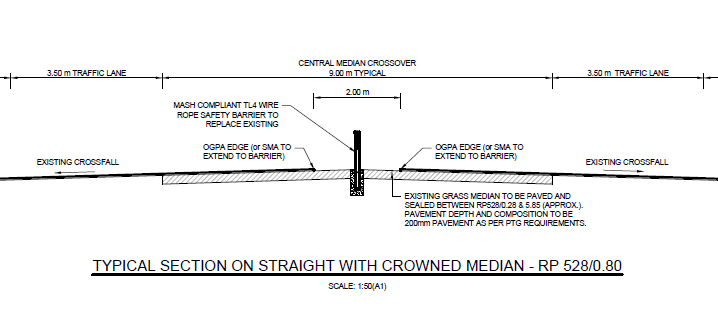 SH1 Waikato Expressway Ngāruawāhia Section
110 km/h Road Safety Retrofit
2 Safety Concerns
SH1 Waikato Expressway Ngāruawāhia Section
110 km/h Road Safety Retrofit
2 Safety Concerns
1982
Act
Figure 3: Proposed surfaced median width
The width of the median shoulders seems to be excessive. General y 3.5 m is accepted as providing
Information
sufficient sight distance past median barriers on minimum radius curves. The Ngāruawāhia section has
generous curve radi .
With such wide median shoulders, there is a risk of irresponsible drivers overtaking on the shoulder and
surprising motorists in the fast lane, notwithstanding the required diagonal road markings and RRPMs.
There is a considerable length of widening required to widen the existing outer shoulders by about 1.0 m
Official
to provide safe 3.0 m wide shoulders in front of the roadside barriers. Considering that the median does
not need to be 9 m wide, there is a possibility that much of the widening work on the outside edge could
be reduced, except for the maintenance bays.
the
From a safety in design perspective (the extended length of time that workers and general traffic would be
exposed to risk during construction) the designers should reconsider the proposed cross-section. It is
noted road safety audits are not a substitute for safety in design audits, but sometimes (such as in this
case) road safety audits can include safety in design concerns where road traffic safety is concerned.
under
Risk Ranking
The road safety audit team has assigned the following risk ranking to this safety concern. In ranking this
concern the road safety audit team has assumed that industry standard temporary traffic management
and speed reduction measures would be in place during construction.
Frequency rating Crashes resulting from this safety concern could be infrequent.
Severity rating
Death or serious injury resulting from this safety concern could be likely.
Risk ranking
The safety concern is therefore deemed to be moderate.
Released
Project Number: 310205002.100.0104
11
 SH1 Waikato Expressway Ngāruawāhia Section
110 km/h Road Safety Retrofit
2 Safety Concerns
Recommendation(s)
SH1 Waikato Expressway Ngāruawāhia Section
110 km/h Road Safety Retrofit
2 Safety Concerns
Recommendation(s)
1 Consider utilising some of the wide median to provide the pavement width required for the
widened outside shoulders, thus eliminating the need for extended construction work along the
1982
roadside.
Decision Tracking
Act
Designer
response
Client safety
engineer
comment
Client decision
Action taken
Information
2.2.2
AQUAPLANING POTENTIAL
MODERATE
With the increased width of surfacing, the potential for aquaplaning in areas previously not subject to or
marginal y subject to the risk of aquaplaning should be addressed in the design.
Risk Ranking
Official
The road safety audit team has assigned the following risk ranking to this safety concern.
Frequency rating Crashes resulting from this safety concern could be common.
the
Severity rating
Death or serious injury resulting from this safety concern could be unlikely.
Risk ranking
The safety concern is therefore deemed to be moderate.
Recommendation(s)
1 Check for aquaplaning potential.
under
Decision Tracking
Designer
response
Client safety
engineer
comment
Client decision
Released
Action taken
Project Number: 310205002.100.0104
12
link to page 19 link to page 19

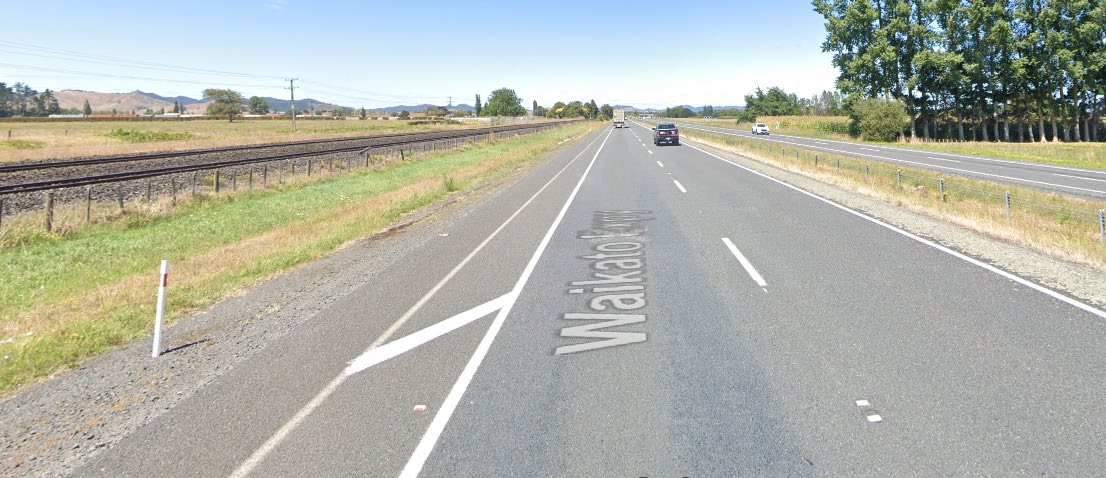
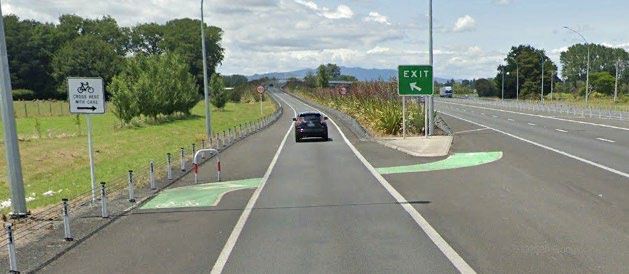 SH1 Waikato Expressway Ngāruawāhia Section
110 km/h Road Safety Retrofit
2 Safety Concerns
2.3 Cyclists
SH1 Waikato Expressway Ngāruawāhia Section
110 km/h Road Safety Retrofit
2 Safety Concerns
2.3 Cyclists
1982
2.3.1
CYCLIST ROAD SIGNS AND MARKINGS
COMMENT
The road safety audit team assumes that cyclists would stil be al owed to use the 110 km/h sections of
the Waikato Expressway.
Act
Some sections of the existing Waikato Expressway cater for cyclists in the form of painted buffer strips
(e.g. Rangiriri to Ohinewai shown i
n Figure 4 below) and signed crossing points across exit and entrance
ramps. shown i
n Figure 5 below. The latter is in an existing 110 km/h speed limit zone. Such shoulder
buffers and cyclist crossings are not present on the Hampton Downs or the Ngāruawāhia or other recently
opened sections such as the Huntly Bypass.
Information
Official
the
Figure 4: Existing buffer strip Rangiriri to Ohinewai (Google, 2021)
under
Released
Figure 5: Exit ramp cyclist crossing at Cambridge (west) interchange (Google, 2019)
Project Number: 310205002.100.0104
13
link to page 21
 SH1 Waikato Expressway Ngāruawāhia Section
110 km/h Road Safety Retrofit
2 Safety Concerns
SH1 Waikato Expressway Ngāruawāhia Section
110 km/h Road Safety Retrofit
2 Safety Concerns
Since the Waikato Expressway looks like a motorway, it would be reasonable to assume that some
drivers would not expect to encounter cyclists in such an environment and would therefore not be looking
out for cyclists.
1982
While the buffer strips and signed crossing points provide no physical protection for cyclists, the signs and
markings may remind drivers to be on the lookout for cyclists. The converse may also be true—where the
signs and markings end or are not present, drivers may think that cyclists are not allowed on the
expressway.
Act
Recommendation(s)
1. A consistent philosophical approach should be taken regarding the provision of cyclist signs and
markings along the entire length of the Waikato Expressway.
Optional Decision Tracking
Designer
response
Client safety
Information
engineer
comment
Client decision
Action taken
Official
2.4 Road Signs and Markings
the
2.4.1
RRPMS AND ATP
COMMENT
The ATP markings applied on the Longswamp to Rangiriri project (June 2020) coincided with the RRPMs.
Not only did the application cover the RRPMs in many cases, but the raised portion of the ATP also
tended to mask the ful effectiveness of the RRPM reflectivity, effectively reducing the RRPM to about half
its reflective area when viewed from the low angle of a passenger vehicle.
Figure 3 shows that the ATP
under
had to be removed ahead of each RRPM.
Released
Project Number: 310205002.100.0104
14
link to page 16

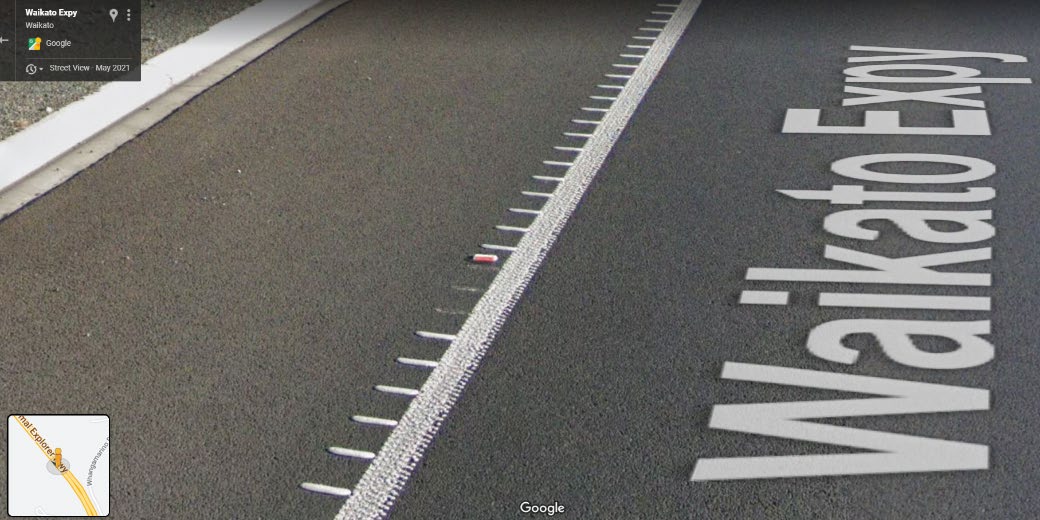 SH1 Waikato Expressway Ngāruawāhia Section
110 km/h Road Safety Retrofit
2 Safety Concerns
SH1 Waikato Expressway Ngāruawāhia Section
110 km/h Road Safety Retrofit
2 Safety Concerns
1982
Act
Figure 6: RRPMs on Longswamp to Rangiriri section (Google, 2021)
The RRPMs should be placed just to the left of the ATP marking.
Recommendation(s)
Information
1 Position the RRPMs to the left of the ATP marking.
Optional Decision Tracking
Designer
response
Official
Client safety
engineer
comment
the
Client decision
Action taken
2.4.2
WIDE SHOULDER MARKINGS
COMMENT
under
As indicated in Secti
on 2.2.1, shoulders wider than 2.5 m (both outside and especially the proposed very
wide median shoulders) should be marked with diagonal bars and RRPMs. It is acknowledged that the
road signs and marking drawings had not yet been completed at the time of the audit.
Recommendation(s)
1 Mark wide shoulders with diagonal bars and RRPMs.
Released
Project Number: 310205002.100.0104
15
 SH1 Waikato Expressway Ngāruawāhia Section
110 km/h Road Safety Retrofit
2 Safety Concerns
Optional Decision Tracking
Designer
response
SH1 Waikato Expressway Ngāruawāhia Section
110 km/h Road Safety Retrofit
2 Safety Concerns
Optional Decision Tracking
Designer
response
1982
Client safety
engineer
comment
Client decision
Act
Action taken
Information
Official
the
under
Released
Project Number: 310205002.100.0104
16


 SH1 Waikato Expressway Ngāruawāhia Section
110 km/h Road Safety Retrofit
3 Audit Statement
3
Audit Statement
SH1 Waikato Expressway Ngāruawāhia Section
110 km/h Road Safety Retrofit
3 Audit Statement
3
Audit Statement
We declare that we remain independent of the design team and have not been influenced in any way by 1982
any party during this road safety audit.
We certify that we have used the available plans, and have examined the specified roads and their
environment, to identify features of the project we have been asked to look at that could be changed,
Act
removed, or modified in order to improve safety.
We have noted the safety concerns that have been evident in this audit and have made
recommendations that may be used to assist in improving safety.
s 9(2)(a)
Signed
Date 28 February 2022
s 9(2)(a)
Technical Director – Roads and Highways, Stantec
Information
s 9(2)(a)
Signed
Date 1 March 2022
Official
s 9(2)(a)
Senior Road Safety Engineer / Road Safety Leader, Stantec
the
Signed
Date 2 March 2022
Heather Liew, BEng(Hons), MET
Safety Engineer, Waka Kotahi
under
Released
Project Number: 310205002.100.0104
17



 SH1 Waikato Expressway Ngāruawāhia Section
110 km/h Road Safety Retrofit
4 Response and Decision Statements
4
Response and Decision Statements
SH1 Waikato Expressway Ngāruawāhia Section
110 km/h Road Safety Retrofit
4 Response and Decision Statements
4
Response and Decision Statements
System designers and the people who use the roads must al share responsibility for creating a road
1982
system where crash forces do not result in death or serious injury.
4.1 Designer’s Responses
Act
I have studied and considered the auditors’ safety concerns and recommendations for safety
improvements set out in this road safety audit report and I have responded accordingly to each safety
concern with the most appropriate and practical solutions and actions, which are to be considered further
by the safety engineer (if applicable) and project manager.
Signed
Date
Designer’s name, qualification, position, company
Information
4.2 Safety Engineer’s Comment (if applicable)
I have studied and considered the auditors’ safety concerns and recommendations for safety
improvements set out in this road safety audit report together with the designer’s responses. Where
appropriate, I have added comments to be taken into consideration by the project manager when
Official
deciding on the action to be taken.
the
Signed
Date
Safety engineer’s name, qualification, position, company
4.3 Project Manager’s Decisions
under
I have studied and considered the auditors’ safety concerns and recommendations for safety
improvements set out in this road safety audit report, together with the designer’s responses and the
comments of the safety engineer (if applicable) and having been guided by the auditor’s ranking of
concerns have decided the most appropriate and practical action to be taken to address each of the
safety concerns.
Released
Signed
Date
Project Number: 310205002.100.0104
18

 SH1 Waikato Expressway Ngāruawāhia Section
110 km/h Road Safety Retrofit
4 Response and Decision Statements
SH1 Waikato Expressway Ngāruawāhia Section
110 km/h Road Safety Retrofit
4 Response and Decision Statements
Project manager’s name, qualification, position, company
4.4 Designer’s Statement
1982
I certify that the project manager’s decisions and directions for action to be taken to improve safety for
each of the safety concerns have been carried out.
Act
Signed
Date
Designer’s name, qualification, position, company
4.5 Road Safety Audit Close Out
The project manager is to distribute the audit report incorporating the decisions to the designer, safety
audit team leader, safety engineer, and project file.
Information
Date
Official
the
under
Released
Project Number: 310205002.100.0104
19
 SH1 Waikato Expressway Ngāruawāhia Section
110 km/h Road Safety Retrofit
5 References
5
References
SH1 Waikato Expressway Ngāruawāhia Section
110 km/h Road Safety Retrofit
5 References
5
References
Google. (2019, December). Street View.
1982
Google. (2021, May). Street View.
Google. (2021, February). Street View.
Act
Information
Official
the
under
Released
Project Number: 310205002.100.0104
20
Document Outline







































